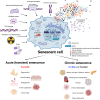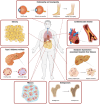Coming of age: could obesity-related metabolic complications be treated by targeting senescent cells?
- PMID: 40535573
- PMCID: PMC12174156
- DOI: 10.3389/fcell.2025.1622107
Coming of age: could obesity-related metabolic complications be treated by targeting senescent cells?
Abstract
Aging is characterized by gradual deterioration of organ or tissue function and its ability to maintain homeostasis of the different physiological processes. This leads to the development of structural and functional alterations accompanied by an increased risk for diverse pathologies. Cellular senescence is a controlled biological process that could contribute to the development of many age-related diseases and related metabolic dysfunctions. Two major chronic diseases associated with premature accumulation of senescent cells that impose an enormous burden on global health systems are obesity and type 2 diabetes mellitus with its related complications. The purpose of this review is to highlight the links between aging, obesity, and type 2 diabetes mellitus, focusing on the role of cellular senescence in disease development and progression. Additionally, this review will discuss the potential of targeting cellular senescence as a promising therapeutic strategy for managing these interrelated diseases, therefore offering a novel approach to prevention and treatment.
Keywords: cellular senescence; metabolic complications; obesity; senolytics; type 2 diabetes mellitus.
Copyright © 2025 Kasperova, Cinkajzlova, Horvath, Svoboda, Haluzik and Stemberkova Hubackova.
Conflict of interest statement
The authors declare that the research was conducted in the absence of any commercial or financial relationships that could be construed as a potential conflict of interest.
Figures



Similar articles
-
Identification of a senescence-associated transcriptional program in skeletal muscle of cachectic pancreatic-tumor-bearing mice.Am J Physiol Cell Physiol. 2025 Apr 1;328(4):C1125-C1134. doi: 10.1152/ajpcell.00816.2024. Epub 2025 Feb 24. Am J Physiol Cell Physiol. 2025. PMID: 39993009 Free PMC article.
-
Assessing the comparative effects of interventions in COPD: a tutorial on network meta-analysis for clinicians.Respir Res. 2024 Dec 21;25(1):438. doi: 10.1186/s12931-024-03056-x. Respir Res. 2024. PMID: 39709425 Free PMC article. Review.
-
Molecular feature-based classification of retroperitoneal liposarcoma: a prospective cohort study.Elife. 2025 May 23;14:RP100887. doi: 10.7554/eLife.100887. Elife. 2025. PMID: 40407808 Free PMC article.
-
Surveillance for Violent Deaths - National Violent Death Reporting System, 50 States, the District of Columbia, and Puerto Rico, 2022.MMWR Surveill Summ. 2025 Jun 12;74(5):1-42. doi: 10.15585/mmwr.ss7405a1. MMWR Surveill Summ. 2025. PMID: 40493548 Free PMC article.
-
Tirzepatide for Weight Loss: Can Medical Therapy "Outweigh" Bariatric Surgery?Cardiol Rev. 2023 Sep-Oct 01;31(5):278-283. doi: 10.1097/CRD.0000000000000515. Epub 2023 Mar 8. Cardiol Rev. 2023. PMID: 36688833 Review.
References
-
- Alessio N., Acar M. B., Demirsoy I. H., Squillaro T., Siniscalco D., Di Bernardo G., et al. (2020). Obesity is associated with senescence of mesenchymal stromal cells derived from bone marrow, subcutaneous and visceral fat of young mice. Aging (Albany NY) 12 (13), 12609–12621. 10.18632/aging.103606 - DOI - PMC - PubMed
Publication types
LinkOut - more resources
Full Text Sources

